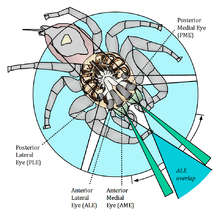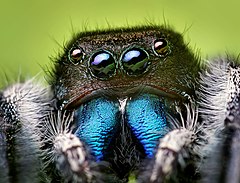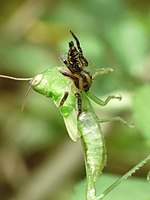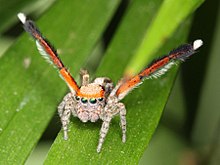 |
photo taken by Ngala Maimo in Bamenda cameroon showing
Organism on a floor |
 |
| photo taken in Bamenda cameroon |
Jumping spiders are a group of spiders that constitute the family Salticidae. This family contains roughly 635 described genera and about 6080 described species, making it the largest family of spiders with about 13% of all species. Jumping spiders have some of the best vision among arthropods and use it in courtship, hunting, and navigation. Although they normally move unobtrusively and fairly slowly, most species are capable of very agile jumps, notably when hunting, but sometimes in response to sudden threats or crossing long gaps. Both their book lungs and tracheal system are well-developed, and they use both systems (bimodal breathing). Jumping spiders are generally recognized by their eye pattern. All jumping spiders have four pairs of eyes, with the anterior median pair being particularly large.

Salticidae male anterior and dorsal aspects, showing positions of eyes
Jumping spiders are among the easiest to distinguish from similar spider families because of the shape of the
cephalothorax and their eye patterns. The families closest to Salticidae in general appearance are the
Corinnidae(distinguished also by prominent spines on the back four legs), the
Oxyopidae (the lynx spiders, distinguished by very prominent spines on all legs), and the
Thomisidae (the crab spiders, distinguished by their front four legs, which are very long and powerful). None of these families however, has eyes that resemble those of the Salticidae. Conversely, the legs of jumping spiders are not covered with any very prominent spines. Their front four legs generally are larger than the hind four, but not as dramatically so as those of the crab spiders, nor are they held in the outstretched-arms attitude characteristic of the Thomisidae. In spite of the length of their front legs, Salticidae depend on their rear legs for jumping. The generally larger front legs are used partly to assist in grasping prey, and in some species, the front legs and
pedipalps are used in species-recognition signalling.
The jumping spiders, unlike the other families, have faces that are roughly rectangular surfaces perpendicular to their direction of motion. In effect this means that their forward-looking, anterior eyes are on "flat faces", as shown in the photographs. Their eye pattern is the clearest single identifying characteristic. They have eight eyes, as illustrated. Most diagnostic are the front row of four eyes, in which the anterior median pair are more dramatically prominent than any other spider eyes apart from the posterior median eyes of the Deinopidae. There is, however, a radical functional difference between the major (AME) eyes of Salticidae and the major (PME) eyes of the Deinopidae; the large posterior eyes of Deinopidae are adapted mainly to vision in dim light, whereas the large anterior eyes of Salticidae are adapted to detailed, three-dimensional vision for purposes of estimating the range, direction, and nature of potential prey, permitting the spider to direct its attacking leaps with great precision. The anterior lateral eyes, though large, are smaller than the AME and provide a wider forward field of vision.
The rear row of four eyes may be described as strongly bent, or as being rearranged into two rows, with two large posterior lateral eyes furthest back. They serve for lateral vision. The posterior median eyes also have been shifted out laterally, almost as far as the posterior lateral eyes. They are usually much smaller than the posterior lateral eyes and there is doubt about whether they are at all functional in many species.
The body length of jumping spiders generally range from 1 to 25 mm (0.04–0.98 in). The largest is
Hyllus giganteus, while other genera with relatively large species include
Phidippus,
Philaeus and
Plexippus.
In addition to using their
silk for safety lines while jumping, they also build silken "pup tents", where they shelter from bad weather and sleep at night. They molt within these shelters, build and store egg cases within them, and also spend the winter in them.
Habitat
Vision

The visual fields of a jumping spider
Jumping spiders have four pairs of eyes; three secondary pairs that are fixed and a principal pair that is movable.
The posterior median eyes (PME) are
vestigial in many species, but in some primitive sub-families they are comparable in size with the other secondary eyes and help to detect motion. While unable to form images, it is suspected that the reduced pair of eyes has a role similar to that of insect ocelli by receiving light from the sky. The photoreceptors in the other secondary pairs are almost exclusively greensensitive, but the PME have two visual pigments different from that in all the other eyes, sensitive to blue and UV-light.
The posterior lateral eyes (PLE) are wide-angle motion detectors which sense motions from the side and behind. Combined with the other eyes, it gives the spider a near 360-degree view of the world.
The anterior lateral eyes (ALE) have the best
visual acuity of the secondary eyes. It has been shown that they are able to distinguish some details as well, and without them no "looming response" will be triggered by motion. Even with all the other pairs covered, jumping spiders in a study could still detect, stalk and attack flies, using the anterior lateral eyes only, which are also sufficiently widely spaced to provide stereoscopic vision.
The
anterior median eyes (AME) have very good
vision. This pair of eyes is built like a telescopic tube with a corneal lens in the front and a second lens in the back that focus images onto a four-layered retina, a narrow boomerang-shaped strip oriented vertically. Physiological experiments have shown they may have up to four different kinds of receptor cells, with different
absorption spectra, giving them the possibility of
tetrachromatic color vision, with sensitivity extending into the
ultraviolet range. As the eyes are too close together to allow
depth perception, and the animals do not make use of
motion parallax, they have evolved a method called image defocus instead. Of the four photoreceptor layers in the retina, the first two closest to the surface contain ultraviolet-sensitive pigments while the two deepest contain green-sensitive pigments. The incoming green light is only focused on the deepest layer, while the other one receives defocused or fuzzy images. By measuring the amount of defocus from the fuzzy layer, it is possible to calculate the distance to the objects in front of them. In addition to receptor cells, also red filters have been detected, located in front of the cells that normally register green light. It seems that all salticids, regardless of whether they have two, three, or four kinds of color receptors, are highly sensitive to UV light. Some species (for example,
Cosmophasis umbratica) are highly
dimorphic in the UV spectrum, suggesting a role in sexual signaling (Lim & Li, 2005). Color discrimination has been demonstrated in behavioral experiments.
The principal, anterior median, eyes have high resolution (11
min visual angle), but the field of vision is narrow, from 2 to 5°. The central region of the retina, where acuity is highest, is no more than six or seven receptor rows wide. However, the eye can scan objects off the direct axis of vision. As the lens is attached to the carapace, the eye's scanning movements are restricted to its retina through a complicated pattern of translations and rotations. This dynamic adjustment is a means of compensation for the narrowness of the static field of vision. It is analogous to the way most
primates move their eyes to focus images of interest onto the
fovea centralis. Such movements within the jumping spider's eyes are visible from outside when the attention of the spider is directed to various targets.
Behavior
Jumping spiders are generally
diurnal, active hunters. Their well-developed internal
hydraulic system extends their limbs by altering the pressure of body fluid (
hemolymph) within them. This enables the spiders to jump without having large muscular legs like a
grasshopper. Most jumping spiders can jump several times the length of their bodies. When a jumping spider is moving from place to place, and especially just before it jumps, it
tethers a filament of
silk (or 'dragline') to whatever it is standing on to protect itself if the jump should fail.
[7] Should it fall, for example if the prey shakes it off, it climbs back up the silk tether. Some species, such as
Portia, will actually let themselves down to attack prey such as a web spider apparently secure in the middle of its web. Like many other spiders that leave practically continuous silk trails, jumping spiders impregnate the silk line with pheromones that play a role in social and reproductive communication, and possibly in navigation.
Certain species of jumping spiders have been shown by experiment to be capable of learning, recognizing, and remembering colors, and adapting their hunting behavior accordingly.
[23]
Hunting
The hunting behaviour of the Salticidae is confusingly varied compared to that of most spiders in other families. Salticids hunt diurnally as a rule, which is consistent with their highly developed visual system. When it detects potential prey, a jumping spider typically begins orienting itself by swivelling its
cephalothorax to bring the
anterior median eyes to bear. It then moves its
abdomen into line with its cephalothorax. After that, it might spend some time inspecting the object of its attention and determining whether a camouflaged or doubtful item of prey is promising, before it starts to stalk slowly forward. When close enough, the spider pauses to attach a dragline, then springs onto the prey.
There are, though, many variations on the theme and many surprising aspects. For one thing, salticids do not necessarily follow a straight path in approaching prey. They may follow a circuitous course, sometimes even a course that takes the hunter through regions from which the prey is not visible. Such complex adaptive behaviour is hard to reconcile with an organism that has such a tiny brain, but some jumping spiders, in particular some species of Portia, can negotiate long detours from one bush down to the ground, then up the stem of another bush to capture a prey item on a particular leaf. Such behaviour still is the subject of research.
Some salticid species are continually on the move, stopping periodically to look around for prey, which they then stalk immediately. Others spend more time scanning their surroundings from one position, actively stalking any prey they detect. Members of the genus Phaeacius take that strategy to extremes; they sit on a tree trunk, facing downwards and rarely do any stalking, but simply lunge down on any prey items that pass close before them.
Some Salticidae specialise in particular classes of prey.
Ants comprise one such class. Most spiders, including most salticids, avoid worker ants, but several species not only eat them as a primary item in their diets, but also employ specialised attack techniques —
Corythalia canosa for example, circles round to the front of the ant and grabs it over the back of its head. Such
myrmecophagous species, however, will not necessarily refuse other prey items, and will routinely catch flies and similar prey in the usual salticid fashion, without the special precautions they apply in hunting dangerous prey such as ants. Ants offer the advantages of being plentiful prey items for which there is little competition from other predators, but it remains profitable to catch less hazardous prey when it presents itself.
Some of the most surprising hunting behaviour occurs among the
araneophagous Salticidae, and it varies greatly in method. Many of the spider-hunting species quite commonly will attack other spiders, whether fellow salticids or not, in the same way as any other prey, but some kinds resort to web invasion; nonspecialists such as
Phidippus audax sometimes attack prey ensnared in webs, basically in acts of
kleptoparasitism — sometimes they leap onto and eat the web occupant itself, or simply walk over the web for that purpose.
Salticidae in the genera
Brettus,
Cyrba,
Gelotia, and
Portia display more advanced web-invasion behavior. They slowly advance onto the web and vibrate the silk with their pedipalps and legs. In this respect, their behaviour resembles that of the
Mimetidae, probably the most specialised of the araneophagous spider families. If the web occupant approaches in the manner appropriate to dealing with ensnared prey, the predator attacks.
The foregoing examples present the Salticidae as textbook examples of active hunters; they would hardly seem likely to build webs other than those used in reproductive activities, and in fact, most species really do not build webs to catch prey. However, exceptions occur, though even those that do build capture webs generally also go hunting like other salticids. Some
Portia species, for example, spin capture webs that are functional, though not as impressive as some orb webs of the
Araneidae;
Portia webs are of an unusual funnel shape and apparently adapted to the capture of other spiders.
Spartaeus species, on the other hand, largely capture moths in their webs. In their review of the
ethology of Salticidae, Richman and Jackson speculate on whether such web building is a relic of the evolution of this family from web-building ancestors.
In hunting, Salticidae also use their silk for a tether to enable them to reach prey that otherwise would be inaccessible. For example, by advancing towards the prey to less than the jumping distance, then retreating and leaping in an arc at the end of the tether line, many species can leap onto prey on vertical or even on inverted surfaces, which of course in a gravitational field would not be possible without such a tether.
Having made contact with the prey, hunting Salticidae administer a bite to inject rapidly acting venom that gives the victim little time to react. In this respect, they resemble the Mimetidae and Thomisidae, families that ambush prey that often are larger than the predator, and they do so without securing the victim with silk; they accordingly must immobilise it immediately and their venom is adapted accordingly.
This small female jumping spider (
Hyllus semicupreus) successfully captured a grasshopper that is much larger and stronger than she is. The grasshopper tried to escape, but the spider immobilized it using the venom she injected, and the "dragline" helped her hold her position with respect to the prey object.
Diet

A camouflaged
Menemerus sp.jumping spider with a captured male ant
Although jumping spiders are generally carnivorous, many species have been known to include nectar in their diets, and one species, Bagheera kiplingi, feeds primarily on plant matter. None are known to feed on seeds or fruit. Extrafloral nectaries on plants, such as Chamaecrista fasciculata (partridge pea), provide jumping spiders with nectar; the plant benefits accordingly when the spiders prey on whatever pests they find.
Reproduction
General mating behavior
Jumping spiders conduct complex, visual courtship displays using both movements and physical bodily attributes. Unlike females, males possess plumose hairs, colored or iridescent hairs (particularly pronounced in the
peacock spiders), front leg fringes, structures on other legs, and other, often bizarre, modifications. These characteristics are used in a courtship "dance" in which the colored or iridescent parts of the body are displayed. In addition to the display of hairs, jumping spiders perform complex sideling, vibrational, or zigzag movements to attract females. If receptive to the male, the female will assume a passive, crouching position. It has also recently been discovered that many males have auditory signals as well. These amplified sounds presented to the females resemble buzzes or drum rolls. In some species, the female may also vibrate her
palps or abdomen. The male will then extend his front legs towards the female to touch her. If the female remains receptive, the male will climb on the female's back and inseminate her with his palps.
Visual and non-visual courtship displays
Species vary greatly in visual and vibratory components of courtship. Many species have patches of UV reflectance, which are exhibited in mature males. This visual component is used by some female jumping spiders for mate choice. Body
size dimorphism seems to play a role in male-male competition, where the larger bodied males will have a fitness advantage to hook the competitor and push down its legs into a vulnerable state, thus impairing the competitor's ability to fight back. Since larger spiders have a better chance of winning the fight, they also have a greater chance to successfully mate and will be favored by
sexual selection..
-
- Phidippus audax is a common jumping spider of North America. It is commonly referred to as the daring jumping spider, or bold jumping spider. The average size of adults ranges from roughly 13–20 millimetres (0.51–0.79 in) in length. They are typically black with a pattern of spots and stripes on their abdomen and legs. Often these spots are orange-tinted in juveniles, turning white as the spider matures. The spider belongs to the genus Phidippus, a group of jumping spiders easily identified both by their relatively large size and their iridescent chelicerae. In the case of Phidippus audax, these chelicerae are a bright, metallic green or blue.
These spiders have been known to jump from 10 to 50 times their own body length by suddenly increasing the blood pressure in the third or fourth pair of legs.
Like other jumping spiders, due to their large, forward-facing eyes, they have very good stereoscopic vision. This aids them when stalking prey, and allows some visual communication with others of their species, such as courting 'dances'.
Habitat

Portrait of an adult male
Phidippus audax showing iridescent chelicerae
Like most jumping spiders, Phidippus audax tends to prefer relatively open areas to hunt in, as they actively seek and stalk prey and do not build webs to catch food. They do use webbing, however, only when laying eggs or to hide. They also use spider silk as a 'lifeline' when jumping for prey or evading predators.
They are common in fields and grasslands, but are frequently seen on fences, exterior walls, and gardens as well. Many jumping spiders seem to prefer flat vertical surfaces, likely due to the fact that it enables them to spot and chase down roaming insects with ease. 5 FUN FACT ABOUT JUMPING SPIDERS
Fun Fact No. 1: Jumping Spiders Really Jump

Away we go!
These little leapers earned their names. But they don’t just hop around because it’s fun. Jumping spiders use their legs to pounce on their prey, which is typically other insects.
Amazingly, jumping spiders don’t have special leg muscles, like grasshoppers, to help them leap. They propel themselves by suddenly changing the blood flow in their body. When a jumping spider wants to soar, it contracts special muscles to increase the flow of blood to its legs. This makes the legs fully extend and sends the spider flying — sometimes as far as 50 times the spider’s body length. Pretty cool, right?
Fun Fact No. 2: They're Excellent Dancers

Wave your legs in the air like you just don't care.
When male jumping spiders want to attract the attention of female jumping spiders, they do a little dance. The dance involves beating their abdomens on the ground and waving their legs in the air. The spiders also tap their feet on the ground so quickly that it can’t be seen by the human eye.
Those are just the simpler dances, though. The peacock spider ups the dance factor by also wooing potential mates with a
brightly colored fan-like extension that he waves around as he stomps and taps.
Fun Fact No. 3: Jumping Spiders Have Great Vision

I see you.
Our fuzzy friend has some of the best vision in the spider world. Jumping spiders have four sets of eyes. There are two large eyes right in front, with a smaller eye on either side. Then, on the top of their heads, jumping spiders have two medium-sized eyes and two smaller eyes.
And those eight adorable eyeballs aren’t just for staring at you. Jumping spiders use their vision to hunt for insects to prey on. Additionally, the female jumping spiders use their peepers to judge the dance moves of the males.
Fun Fact No. 4: They Don't Hunt Using Webs

Who needs a web?
Unlike many spiders, the jumping spider doesn’t trap prey using a web. With its outstanding long-jump hunting abilities, why would it need to?
That doesn’t mean these furry cuties aren’t capable of making silk, though. Some jumping spiders will spin tiny tents or shelters to protect them from rain or nighttime predators. Additionally, whenever the spider takes a leap, it anchors itself using a string, just in case it misses its target.
Fun Fact No. 5: They Mimic Other Insects

Hiding in plain sight.
Myrmarachne melanocephala, also know as ant-mimicking spiders are a species of jumping spiders who are masters of disguise. These little leapers act like ants to fool predators and prey.
They’re longer than most jumping spiders, and have narrow false waists to make them appear more ant-like. These spiders will also take on the colors of different types of ants. In addition, they wave two of their legs around like antennae to better blend in. Pretty smart, huh?
Like we said, these fuzzy little guys are actually pretty cool once you get to know them. Many bugs are. So if you’re ready to leap into more interesting insect info, read up on the monarch butterfly and its amazing migration habits.
























